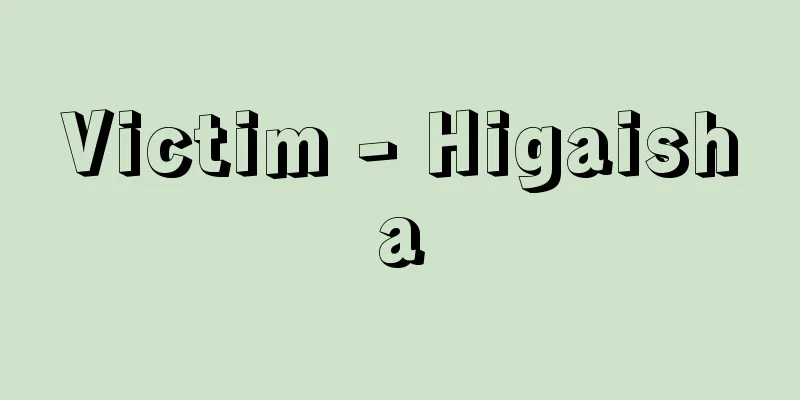Victim - Higaisha

|
A person whose life, body, freedom, honor, property, or other interests have been violated or threatened by a civil tort or a criminal crime. Usually, the latter, criminal victim, is distinguished from the former as a "crime victim." In a broader sense, it can also refer to those who have been harmed by war, disasters, accidents, etc., but it usually refers to a crime victim. In recent years, in the field of prevention, such as environmental criminology, people who have not yet been victimized are studied as potential victims. Generally, crimes are accompanied by victims, but sometimes the theme of "victimless crime" is discussed, and in cases such as prostitution, drug abuse, gambling, and homosexuality, it is said that there are no victims. This argument is a decriminalization argument that acts without victims should not be punished, but with the exception of homosexuality, which has been socially accepted in recent years, these acts are punished in many countries, and in such cases, the victim is considered to be the state or society in general. Historically, the status of crime victims was officially recognized by the "Tallio Law" (principle of retaliation) and the right to take revenge (blood vendetta) against the perpetrator, his/her family, and/or tribe, and private lawsuits were also allowed in courts. However, as society modernized, the right of victim revenge was denied, and when modern states were born and the state's right to punish was established, all crimes came to be considered acts against the order of the state, and the status of victims rapidly declined, and in criminal proceedings, they were only involved in investigations and trials as witnesses or witnesses. However, since the 1960s, the legal status of victims has risen worldwide, and starting with the crime victim compensation system that began in New Zealand, victims have been elevated to the status of being eligible for various relief, protection, and rights protection. Furthermore, in some parts of the world, restorative justice systems have been introduced in which victims and perpetrators are discussed in the form of conferences instead of trials. In criminology, too, discussions about victims have not been a central theme for a long time, but the existence of victims has come into the spotlight since the beginning of victimology, which focuses on victims, around the time of World War II, the development of environmental criminology, which focuses on potential victims, and the implementation of dark count surveys of victims who have been forced to accept their crimes in society. Today, emphasis is being placed on crime prevention measures that do not create victims in the first place. [Tadashi Moriyama May 21, 2018] [Reference items] | | | | | |Source: Shogakukan Encyclopedia Nipponica About Encyclopedia Nipponica Information | Legend |
|
民事上の不法行為、または刑事上の犯罪によって生命、身体、自由、名誉、財産等の利益を侵害された者ないし侵害の脅威を受けた者。通常、後者の刑事上の被害者は「犯罪被害者」として前者と区別される。また、さらに広義では戦争、災害、事故などで害を受けた者もさす場合があるが、通常は犯罪被害者をいう場合が多い。また近年の環境犯罪学などの未然予防の領域では、まだ被害にあっていない者を潜在的被害者として研究対象にしている。一般に犯罪発生には被害者が伴うが、ときには「被害者なき犯罪victimless crime」というテーマで論じられることもあり、売春、薬物濫用、賭博(とばく)、同性愛などの例では被害者は存在しないとされた。この議論は、被害者がいない行為は処罰すべきではないとする非犯罪化の議論であるが、近年社会的に認知された同性愛は別として、これらの行為は多くの国で処罰されており、その場合、被害者は国家ないし社会一般とみなされている。 歴史的にみると、犯罪被害者の地位は「タリオの法」(同害報復の原則)などによって加害者やその家族、部族への復讐(ふくしゅう)(血讐)が正式に承認され、また裁判においても私訴が認められていたが、社会が近代化するにつれて被害者の復讐が否定され、近代国家が誕生し国家刑罰権が確立すると、犯罪はすべて国家の秩序に反する行為とみなされるようになり、被害者の地位は急激に低下し、刑事手続では単に参考人や証人、目撃者などの形で捜査や裁判に関与するにすぎなかった。しかし、1960年代以降、世界的に被害者の法的地位が上昇し、ニュージーランドで始まった犯罪被害者補償制度を皮切りに、各種の救済・保護、権利保障などの対象にまで高められた。さらに、海外の一部では裁判にかわるカンファレンスという形式で加害者と話し合う修復的司法(リストラティブ・ジャスティスrestorative justice)制度が導入されている。 犯罪学においても、被害者をめぐる議論は長く中心テーマではなかったが、第二次世界大戦の前後から被害者に焦点をあてる被害者学、1970年代から潜在的被害者に焦点をあてる環境犯罪学の展開、さらには社会的に泣き寝入りした被害者を対象とする暗数調査などが行われるようになるにつれて、被害者の存在が脚光を浴びるようになった。今日では、そもそも被害者を生み出さない犯罪予防対策が重視されるようになっている。 [守山 正 2018年5月21日] [参照項目] | | | | | |出典 小学館 日本大百科全書(ニッポニカ)日本大百科全書(ニッポニカ)について 情報 | 凡例 |
<<: Victim compensation - Higaishahosho
>>: Sarcocheilichthys variegatus - Sarcocheilichthys variegatus
Recommend
Magemono - Magemono
A container made by bending a thin board of cypre...
Andrée, SA (English spelling) AndreeSA
…On the other hand, expeditions were launched to ...
Takayama Ukon
A military commander and Christian feudal lord du...
Sekichukei
The valley of the Doudou River, a small tributary ...
Okayama Port
A port in Okayama Prefecture. Located at the mouth...
Champs-Élysées (English spelling) Avenue des Champs-Élysées
A boulevard in the west of Paris (8th arrondissem...
Kanamori Yoritoki (■1)
...Modern daimyo. Sadachika, the son of Sadayori,...
NUL - NUL
→National Cities Alliance Source: Shogakukan Ency...
Dibutyl phthalate
…By adding plasticizers in this way, the properti...
"Itako Jinku" - Itako Jinku
...In June, when the Japanese irises bloom, there...
Edinburgh Skating Club
…Iron skates were gradually improved, and by the ...
Weitling, Wilhelm
Born: October 5, 1808, Magdeburg [Died] January 22...
The origin of the Kumano Gongen deity's appearance - Kumano Gongen Gosuijaku Engi
This is a record of the events that led to Kumano ...
Original Calories
When calculating the energy intake from food, the ...
Warren, HE
… [Electric/Electronic Clocks] The idea of usin...









